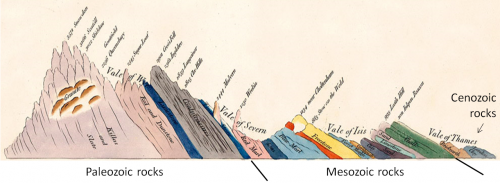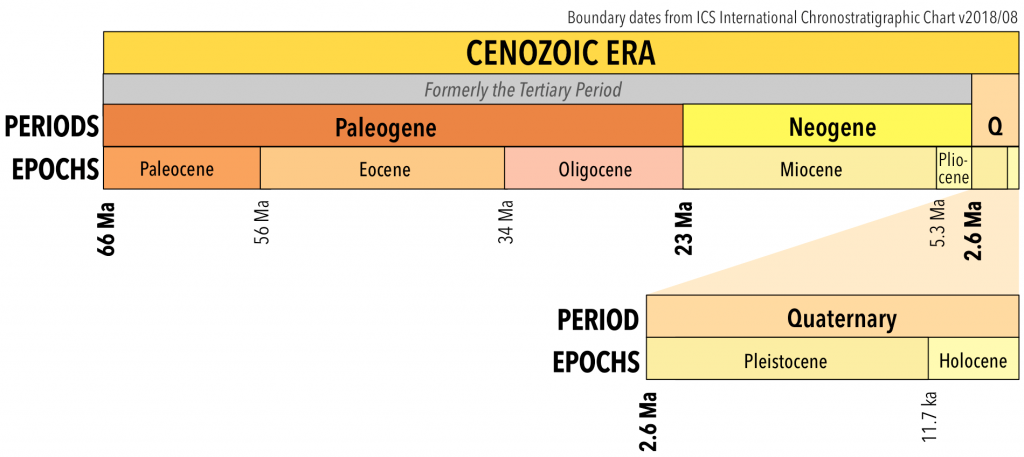19.1 The Geological Timescale
Developing the Geological Timescale
James Hutton (1726-1797) was a Scottish geologist, and considered by some to be the originator of modern Geology. Hutton studied present-day processes and applied his observations to the rock record in order to understand what he saw there. Such a method is now encapsulated in the principle of uniformitarianism, which states that the present is the key to the past. Given how slowly geological processes happen, Hutton concluded that geological time must be very long indeed to account for the large changes apparent in the rock record. But this principle needs to be taken with a grain of salt: there are some processes that have happened in the past that are no longer occurring (e.g., eruption of ultramafic lavas), and some processes that occur so irregularly that we have yet to witness such an event in historic time (e.g., impact of a large asteroid with Earth).
William Smith worked as a surveyor in the coal-mining and canal-building industries in southwestern England in the late 1700s and early 1800s. While doing his work, he had many opportunities to observe ancient sedimentary rocks in the region, and noticed that he could trace rocks from one area to the next based textural similarities and differences. He also noticed that fossils could be used to match up rocks of the same age. Smith is credited with formulating the principle of faunal succession, the concept that specific types of organisms lived during different time intervals. He used the principle of faunal succession to great effect in his monumental project to create a geological map of England and Wales, published in 1815.
Inset into Smith’s great geological map is a small diagram showing a schematic geological cross-section extending from the Thames estuary of eastern England to the west coast of Wales. Smith showed the sequence of rocks, from the Paleozoic rocks of Wales and western England, through the Mesozoic rocks of central England, to the Cenozoic rocks of the area around London (Figure 19.2).

Smith didn’t put any dates on these rocks, because he didn’t know them. But he was aware of the principle of superposition, the idea developed much earlier by the Danish theologian and scientist Nicholas Steno, that young sedimentary rocks form on top of older ones. Therefore, Smith knew that this diagram represented a stratigraphic column. And since almost every period of the Phanerozoic is represented along this section through Wales and England, it is also a primitive geological timescale.
Smith’s work set the stage for the naming and ordering of the geological time periods, which was initiated around 1820, first by British geologists, and later by other European geologists. Many of the periods are named for places where rocks of that age are found in Europe, such as Cambrian for Cambria in Wales, Devonian for Devon in England, Jurassic for the Jura Mountains in France and Switzerland, and Permian for the Perm region of Russia. Some are named for the type of rock that is common during that age, such as Carboniferous for the coal-bearing rocks of England, and Cretaceous for the chalks of England and France.
The early time scales were only relative because 19th century geologists did not know the absolute ages of rocks (i.e., the age as a number). This information was not available until the development of isotopic dating techniques early in the 20th century.
Today’s Geologic Timescale
Eons: The Longest Intervals
The geological timescale is currently maintained by the International Commission on Stratigraphy (ICS), which is part of the International Union of Geological Sciences. The timescale is continuously being updated as we learn more about the timing and nature of past geological events. View the ICS timescale.
Geological time has been divided into four eons: Hadean, Archean, Proterozoic, and Phanerozoic (Figure 19.3). The first three of these eons represent almost 90% of Earth’s history. Rocks from the Phanerozoic (meaning “visible life”) are the most commonly exposed rocks on Earth, and they contain evidence of life forms with which we are familiar.

Place the eons and eras in the correct order.
- Today
- Era
- Era Eon
- Era
- 541 Ma
- Eon
- 2500 Ma
- Eon
- 4000 Ma
- Eon
- 4600 Ma
Fill-in-the-blank options:
- Phanerozoic
- Cenozoic
- Hadean
- Paleozoic
- Proterozoic
- Mesozoic
- Archean
To check your answers or try a more difficult version of this question, navigate to the below link.
Divisions of the Phanerozoic Eon
The Phanerozoic — the past 541 Ma of Earth’s history — is divided into three eras: the Paleozoic (“early life”), the Mesozoic (“middle life”), and the Cenozoic (“new life”), and each era is divided into periods (Figure 19.4). Most of the organisms with which we share Earth evolved into familiar forms at various times during the Phanerozoic.

Practice with Divisions of the Phanerozoic Eon
This exercise has three levels of difficulty.
- Today
- Era
- 66 Ma
- Period
- Period Era
- Period
- 252 Ma
- Period
- Period
- Period
- Period
- Period Era
- Period
- 541 Ma
Fill in the blank options:
- Mesozoic
- Silurian
- Cenozoic
- Ordovician
- Cambrian
- Devonian
- Triassic
- Carboniferous
- Jurassic
- Permian
- Paleozoic
- Cretaceous
To check your answers or try a more difficult version of this question, navigate to the below link.
Divisions of the Cenozoic Era
The Cenozoic, representing the past 66 Ma, is divided into three periods: the Paleogene, Neogene, and Quaternary. The periods are subdivided into seven epochs (Figure 19.5). Non-avian dinosaurs became extinct at the start of the Cenozoic, after which birds and mammals radiated to fill the available habitats. Earth was very warm during the early Eocene, and has cooled steadily ever since. Glaciers first appeared on Antarctica in the Oligocene and then on Greenland in the Miocene. By the Pleistocene, glaciers covered much of North America and Europe. The most recent of the Pleistocene glaciations ended ~11,700 years ago. The current epoch is known as the Holocene. Epochs are further divided into ages.

Most of the boundaries between the periods and epochs of the geological timescale have been fixed on the basis of significant changes in the fossil record. For example, the boundary between the Cretaceous and the Paleogene coincides exactly with the extinction of the non-avian dinosaurs. Many other types of organisms went extinct at this time, and the boundary between the two periods marks the division between sedimentary rocks containing Cretaceous organisms below, and those containing Paleogene organisms above.
Practice with Divisions of the Cenozoic Era
Place the periods and epochs of the Cenozoic Era in the correct order.
- Today
- Epoch Period
- Epoch
- 2.6 Ma
- Epoch Period
- Epoch
- 23 Ma
- Epoch
- Epoch Period
- Epoch
- 66 Ma
Fill in the blank options:
- Ecocene
- Pleistocene
- Paleocene
- Paleogene
- Miocene
- Oligocene
- Quaternary
- Holocene
- Pliocene
- Neogene
To check your answers or try a more difficult version of this question, navigate to the below link.
References
Smith, W. (1815). A delineation of the strata of England and Wales with part of Scotland. [map].

